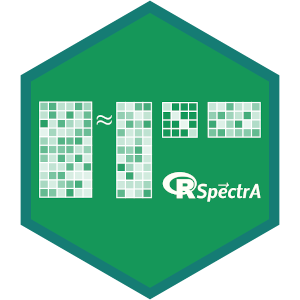RSpectra is an R interface to the
Spectra library.
It is typically used to compute a few eigenvalues/vectors of an n by n
matrix, e.g., the k largest eigen values, which
is usually more efficient than eigen() if k << n.
Currently this package provides the function eigs() for eigenvalue/eigenvector
problems, and svds() for truncated SVD. Different matrix types in R,
including sparse matrices, are supported. Below is a list of implemented ones:
matrix(defined in base R)dgeMatrix(defined in Matrix package, for general matrices)dgCMatrix(defined in Matrix package, for column oriented sparse matrices)dgRMatrix(defined in Matrix package, for row oriented sparse matrices)dsyMatrix(defined in Matrix package, for symmetric matrices)dsCMatrix(defined in Matrix package, for symmetric column oriented sparse matrices)dsRMatrix(defined in Matrix package, for symmetric row oriented sparse matrices)function(implicitly specify the matrix by providing a function that calculates matrix productA %*% x)
We first generate some matrices:
library(Matrix)
n = 20
k = 5
set.seed(111)
A1 = matrix(rnorm(n^2), n) ## class "matrix"
A2 = Matrix(A1) ## class "dgeMatrix"General matrices have complex eigenvalues:
eigs(A1, k)
eigs(A2, k, opts = list(retvec = FALSE)) ## eigenvalues onlyRSpectra also works on sparse matrices:
A1[sample(n^2, n^2 / 2)] = 0
A3 = as(A1, "dgCMatrix")
A4 = as(A1, "dgRMatrix")
eigs(A3, k)
eigs(A4, k)Function interface is also supported:
f = function(x, args)
{
as.numeric(args %*% x)
}
eigs(f, k, n = n, args = A3)Symmetric matrices have real eigenvalues.
A5 = crossprod(A1)
eigs_sym(A5, k)To find the smallest (in absolute value) k eigenvalues of A5,
we have two approaches:
eigs_sym(A5, k, which = "SM")
eigs_sym(A5, k, sigma = 0)The results should be the same, but the latter method is far more stable on large matrices.
For SVD problems, you can specify the number of singular values
(k), number of left singular vectors (nu) and number of right
singular vectors(nv).
m = 100
n = 20
k = 5
set.seed(111)
A = matrix(rnorm(m * n), m)
svds(A, k)
svds(t(A), k, nu = 0, nv = 3)Similar to eigs(), svds() supports sparse matrices:
A[sample(m * n, m * n / 2)] = 0
Asp1 = as(A, "dgCMatrix")
Asp2 = as(A, "dgRMatrix")
svds(Asp1, k)
svds(Asp2, k, nu = 0, nv = 0)and function interface
f = function(x, args)
{
as.numeric(args %*% x)
}
g = function(x, args)
{
as.numeric(crossprod(args, x))
}
svds(f, k, Atrans = g, dim = c(m, n), args = Asp1)